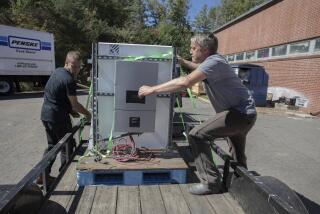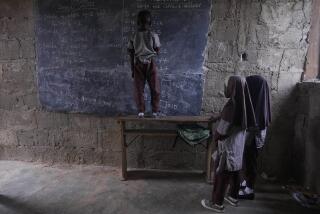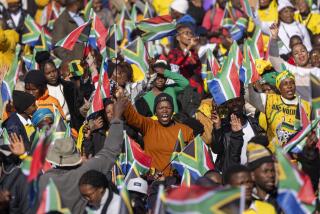S. Africa Bringing Power to the People
DRIEZIK, South Africa â A single bare bulb dangles on a cord, but the dim glow is enough for a shack so tiny it is cramped with a table, three broken chairs and a bed stretching from wall to wall.
The kitchen is a battered bucket, filled at the tap outside for drinking, washing and bathing. Faded magazine photos of soccer stars and a 1993 calendar are the only decorations. Hammered together from sheets of rusting tin, the one-room shanty is freezing in winter and a sweatbox in summer.
It may not look like much--but to Albert Mvunda, just seeing the inside of his home is a near-miracle. Until last year, he and his neighbors had never had electricity.
âWeâve waited our whole life,â said the 42-year-old Mvunda, who is jobless. âWe are overjoyed.â
Added his wife, Ester: âIt is a blessing. . . . Our life is much easier.â
Now their son, Benjamin, 12, doesnât need candles to do homework. Mrs. Mvunda can flick on an electric kettle, instead of building a fire, for a quick cup of tea before rushing off to work as a janitor. The Mvundas are saving up for a hot plate. They already own a radio and a small television.
Almost two years after the dawn of South Africaâs nonracial democracy, President Nelson Mandelaâs government has largely failed to meet its promises to provide better jobs, housing, schools and other visible benefits to most of the nationâs desperately poor.
But amid the growing concern and fears for the future, one resounding success is often overlooked: Eskom, the national power utility, is providing power to the people.
It has wired about 525,000 homes--almost all in impoverished black townships like this one--since Mandelaâs election in April 1994. In November alone, the utility hooked up a record 47,000 new homes. It aims to electrify 300,000 more this year and every year until the end of the decade.
Working with municipal governments and smaller utilities, Eskom has set a goal of wiring two out of three homes in South Africa by the end of 1999--more than double the total when the push began four years ago. About 20 million people, or just under half the population, now have power.
And unlike other development programs, Eskomâs pays its own way: The estimated $1.4-billion project is funded by sales of power and by money borrowed on capital markets. There is another benefit: The utility is hiring local crews for hookups, creating 20,000 jobs and giving a jolt to local economies.
The fast-spreading jungle of concrete poles and dangling wires--plus a profusion of TV aerials--above hundreds of black townships, shantytowns and worker hostels goes a long way toward illuminating why opinion polls show a majority of blacks remain patient with the governmentâs progress.
âWe must not lose hope so quickly,â said Rosalina Makhoba, 31, an unemployed woman in Orange Farm, a dusty sprawl of tin shacks and cinder-block homes on treeless plains about 35 miles south of Johannesburg. âThere are so many problems.â
As she spoke, two workers drilled holes and bolted a white meter to the wall of her one-room shack. Two others ran a wire to a nearby pole. In 20 minutes, Mrs. Makhoba had electricity for the first time in her life.
âNow we will have light!â she said with excitement. âNow I can iron. Now I can cook.â
Long taken for granted in the industrialized West, to many in South Africa the shift to electric power has been as dramatic as the shift in political power.
Choking pollution and deadly fires have decreased in some areas as kerosene, paraffin and coal give way to modern conveniences. The independent Medical Research Council has predicted a sharp drop in burns, paraffin poisoning and especially pneumonia, which is a leading cause of death in children.
Crime in some townships has dropped as more people stay home to watch TV at night, officials say. Sales of refrigerators, hot plates and other appliances have grown. And most important, perhaps, electricity has created jobs and opportunities for small entrepreneurs, from welders to dressmakers.
Euphenia Mngadi has expanded her womenâs cooperative since its dusty corner of Orange Farm was wired two months ago. Using donated equipment, the workers bake 32 loaves of bread each day in an electric oven, make clothes on electric sewing machines and cook lunch on an electric stove in the nursery.
âWe hope to make a little money soon,â she said, sorting bread in a former shipping container that is now used as the bakery. âBut weâre so small.â
Eskom is not. With 19 power plants, including the Koeberg nuclear facility outside Cape Town, Eskom--an Afrikaans acronym for Electricity Supply Commission--is the worldâs fourth-largest utility. It supplies nearly all the electricity used in South Africa and more than half the electricity consumed in all of Africa.
Established in 1923, the de facto monopoly had $13 billion in assets and $4.2 billion in revenue in 1994. It gets no government money and pays no taxes. And its 37,840-megawatt generating capacity is so large that no new power plants will be needed to meet current growth.
For now, the electrification drive is the only part of the governmentâs vaunted Reconstruction and Development Program--an ambitious blueprint for post-apartheid reform--that is meeting its targets. It has raced far ahead of other government programs.
âIf they ever get their housing projects off the ground, weâd be very happy,â said Peter Adams, Eskom spokesman. âAt the moment, we have to scrounge around looking for communities to electrify. . . . We had forecast much higher consumption by now.â
Eskomâs current success has a certain irony. During apartheid, the company was a symbol of white power. Indeed, Eskom had a private army and armory--second in size only to the governmentâs defense forces--to protect transmission lines, generating plants and other facilities against sabotage by anti-apartheid guerrillas.
At the same time, black consumers were penalized under a white-minority government that deliberately denied them electricity, as well as the vote, decent schools, proper health care and other basic services.
âOne thing we failed very miserably at in the past was to bring electricity to the black community,â Adams conceded. âWe were encouraged to [ignore blacks], but thatâs no excuse. Almost every white had electricity, and almost no blacks did.â
The unfairness didnât end there. Eskom sold power to 450 local authorities that functioned as middlemen. The result was about 2,000 electrical rate structures across the country. Highly arbitrary rates, many still in effect, meant blacks often were charged far more than whites.
Until 1993, for example, white municipal officials in Johannesburg resold Eskomâs electricity to Soweto, the vast ghetto of matchbox homes and slums on the cityâs border. Indigent Soweto residents wound up paying double the rates that wealthy whites did and received far worse service.
âIf the power went out, you could wait a week, a month or even longer for a crew to show up,â Adams said. âAnd a bill could say anything. It bore no relation to reality. Youâd find a little lady, a pensioner, living in a tiny shack with a single light bulb and sheâd get a bill for 5,000 rand [$1,369]. Itâs no wonder people said, âStuff it, weâre not going to pay.â â
The continued refusal by a majority of blacks to pay for housing, water and other services, once encouraged by anti-apartheid forces to make the townships âungovernable,â has hampered government reconstruction efforts.
To fight back, Eskom now installs pay-as-you-go meters. New customers pay $12.50 for a hookup, then buy computer-encoded cards from local merchants who work on commission. The cards, which cost as little as $1.38, are used like coins in a meter. The power stays on until the money runs out.
âItâs much like buying petrol or paraffin or any other energy source,â said Phumlani Moholi, a local Eskom official. âYou buy it, you use it, and then you buy some more.â
But major problems persist. Many residents tap or âbridgeâ lines to steal power. In Palm Springs township, for example, up to 90% of the residents are âvoltage pirates,â officials said. Illegal wires snake across roads, drape over backyard fences and hang overhead like black spaghetti.
âWe tried to cut these people off,â said Isaac Mohapinyane, an Eskom supervisor. âThey organized themselves and came ready to fight. They insisted we turn them back on. We are afraid of violence, so we did it.â
Tapping has other risks. A meter can explode, causing fires. And two men in the Orange Farm township recently were electrocuted while pilfering.
Other crimes also have hurt Eskomâs drive. In Orange Farm recently, thieves broke into the utilityâs office and stole everything from typewriters to teacups. Three trucks were hijacked as well.
Even hiring local workers has created unforeseen difficulties. Township toughs have tried to extort money from utility crews. And many of the men hired to dig holes, move fences and help with hookups have been unhappy when the work--and the pay--stop.
âSo when they got close to finishing, the workers would go slow,â said Tshepi Moiloe, an Eskom official. âThings began to disappear. Or break. Or the people we hire, after we leave, they sell their services to tap the lines so people donât have to pay. Itâs been a real problem.â
Some critics say Eskom has been slow to embrace solar energy as a cheaper alternative to electricity, especially in rural areas. Proposals to use solar panels on schools, clinics and other public facilities have yet to take off.
âBecause Eskom is driving the electrification policy, solar power is not really given a chance,â complained Bronwyn James, a researcher at the Energy for Development Research Center, an independent group at the University of Cape Town.
But in Johandeo, another newly wired shantytown, Joseph Nhlapho has another complaint, one familiar to parents elsewhere. His son, Tebono, 12, has a new hobby. âHe watches TV all the time,â Nhlapho said with a laugh. âItâs too much.â
More to Read
Sign up for Essential California
The most important California stories and recommendations in your inbox every morning.
You may occasionally receive promotional content from the Los Angeles Times.











